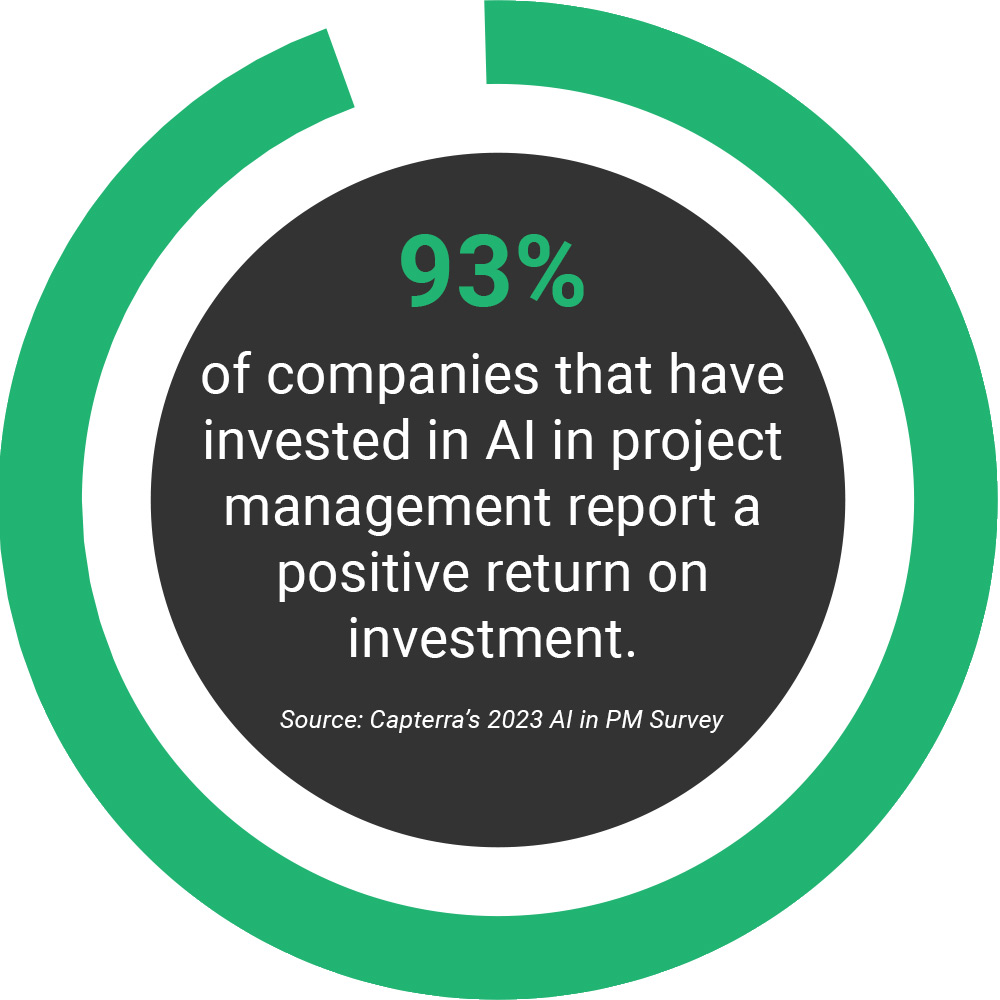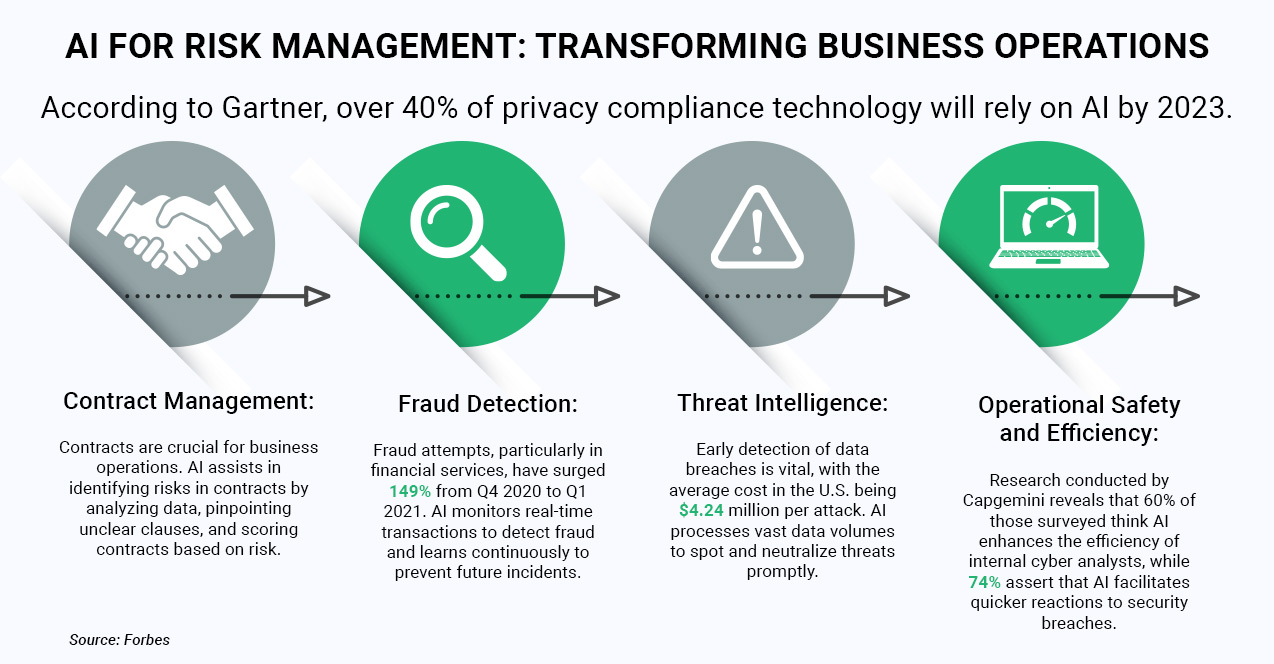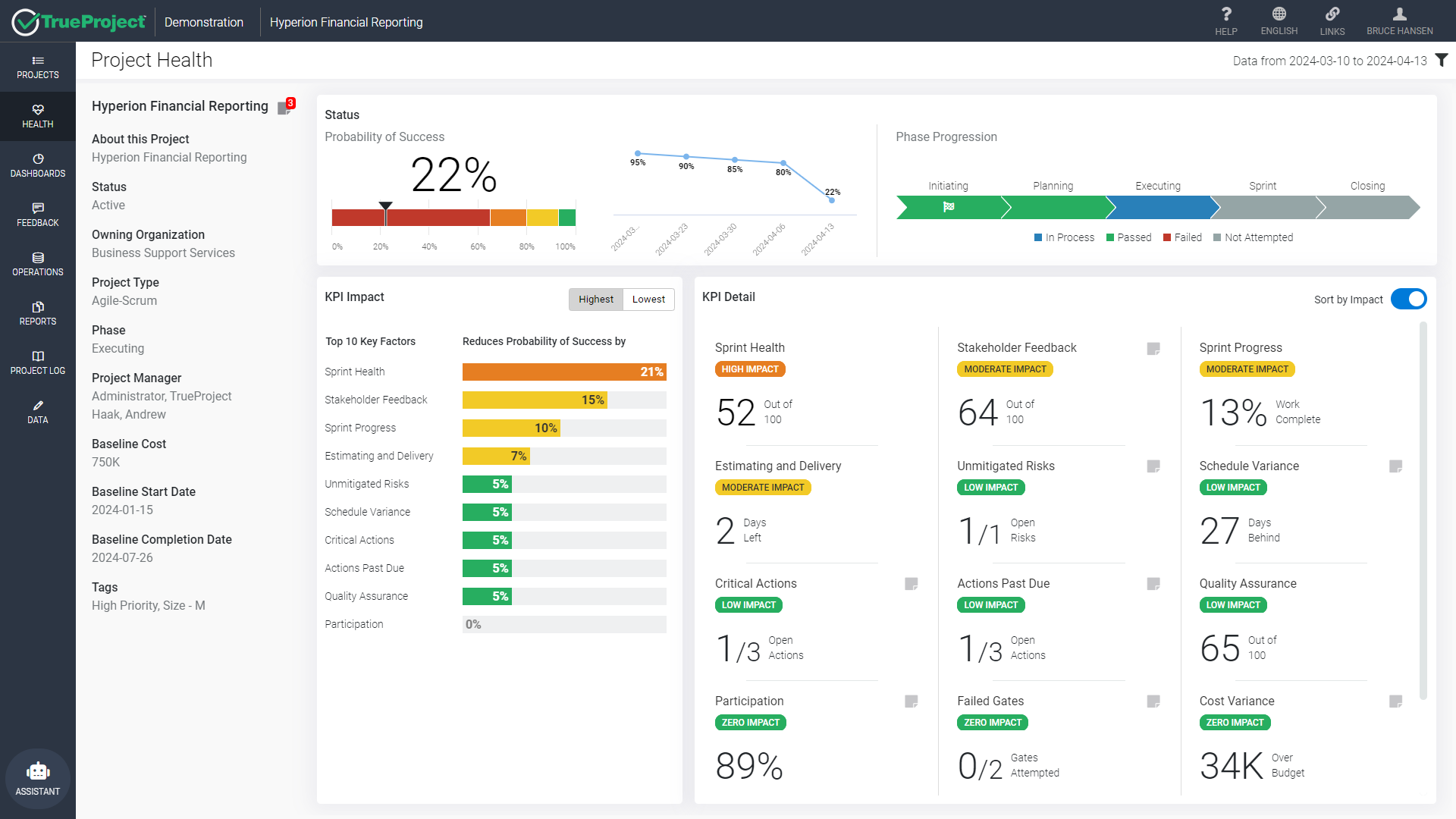
According to a recent Forrester report, by 2025, every enterprise company will utilize artificial intelligence (AI) solutions to manage risks. Risk management has traditionally depended on leveraging data and experience to make informed decisions. However, with the introduction of AI for risk management, this field is experiencing a transformative shift in reshaping decision-making processes. How, you ask?
This article will answer questions about how AI for risk management is pivotal in today’s dynamic business environment, particularly in enhancing the management of IT projects and reshaping traditional business models. In addition, we will offer a path forward to realize predictive and AI-based project risk management today.
In the not-too-distant future, envision a scenario where the C-suite executives of an IT company effortlessly monitor their organization’s strategic initiatives through an AI-enabled project solution. With just a few taps, they can assess each project's progress and performance metrics, instantly access project charters and critical performance indicators, and even gauge team morale and stakeholder engagement. During strategic meetings, the team can identify potential project risks, swiftly reach a consensus to mitigate them, and update the project plan in real-time. Notifications automatically inform relevant team members and stakeholders about updates and anticipated outcomes.
This advanced approach averts potential project derailments, transforming vast amounts of project data into actionable insights and ensuring that each initiative is on track to meet the business goals. Although managing projects today may not always proceed so seamlessly, such technological advancements are here to make a shift, offering an unprecedented level of project insight and control. Therefore, innovators and organizations must invest in AI-driven project risk management solutions to achieve this future sooner.
 AI for Risk Management: Its Role and Application
AI for Risk Management: Its Role and Application
Projects or initiatives are the backbones of business success as they enable the structured implementation of strategies and innovations, helping companies to adapt, grow, and compete effectively. Annually, an astounding $48 trillion is invested in projects worldwide. However, the Standish Group reports that only 35% of these projects are successful. The implications of the remaining 65%—representing a significant resource loss and missed opportunities—are staggering.
For years, research and publications have advocated for the modernization of project execution solutions. One key factor contributing to low project success rates is the outdated technology used to manage these projects. Many business and project leaders still rely on basic tools like spreadsheets and slides, which have seen little innovation over the past decades. Furthermore, these solutions offer descriptive analytics—insights into “why a project failed.” While these solutions may suffice for projects judged solely on deliverables and deadlines, they are inadequate in today's dynamic business environment, where projects and initiatives constantly evolve and reshape the business landscape. This after-the-fact analysis is helpful in a retrospective way but certainly not effective for the millions of dollars invested in the project or projects at hand.
Utilizing AI for risk management processes vast amounts of data, recognizes patterns, and predicts potential risks more accurately and quickly than traditional methods. This predictive and prescriptive capability allows businesses to be more proactive than reactive, providing them with a strategic advantage by identifying and mitigating risks before they manifest into significant threats. The potential impact of integrating AI and significantly predictive analytics into managing project portfolios is profound. Even a modest improvement of 25% in project success rates could translate into trillions of dollars in added value for organizations, stakeholders, and employees. Embracing AI-powered predictive intelligence technology necessary for this risk management is a game-changer for projects across industries; the critical question is how they will be effectively implemented in managing project portfolios.
Research from Gartner anticipates significant changes on the horizon. It predicts that by 2030, AI will execute 80% of project tasks, utilizing advancements in big data, machine learning, and predictive analytics. Fascinating, isn’t it?

AI for Risk Management: What Benefits Can You Reap?
Using AI for risk management offers several critical advantages for businesses striving to stay abreast of technological advancements. One of the primary benefits of integrating AI for risk management is its ability to process vast volumes of data, enabling informed decision-making that saves time and reduces costs swiftly and accurately. This capability is vital in the digital era, where adapting to rapid technological changes is essential for business survival and growth. Furthermore, it offers:
- Real-Time Insights: AI analyzes data in real-time, providing risk managers with the most current information to guide their decisions.
- Reduction of Human Error: By leveraging AI for risk management, you, the business leader, can minimize the biases and errors inherent in human analysis, leading to more accurate assessments.
- Unbiased Decision-Making: AI offers data-driven insights free from human biases, ensuring decisions are based on factual data.
- Pattern Recognition: Integrating AI for risk management can detect patterns and correlations in data that may not be apparent to human analysts, aiding in more strategic risk identification and management of project portfolios.
- Adaptability: AI helps businesses keep pace with rapid technological changes, which is essential for maintaining a competitive advantage in the digital age.
These advantages illustrate how AI revolutionizes risk management, providing tangible advantages that enhance organizational efficacy and strategic oversight.
AI for Risk Management: What Should C-Suite Executives Know?
C-suite executives must be well-informed about AI's application for risk management within their organization and in the broader industry. They should stay updated on the latest frameworks, policies, and legislation to balance transparency and accountability when using algorithms. Executives must advocate for comprehensive reviews to verify that these solutions produce expected outcomes and that adequate controls are in place to monitor their performance over time.

Critical considerations for C-suite executives include:
- Data Quality and Availability: AI's effectiveness for risk management heavily depends on the quality and quantity of data available. Poor data can lead to inaccurate predictions.
- Integration with Existing Systems: Implementing AI-powered predictive intelligence solutions may require significant changes to project systems and workflow management.
- Costs: Initial setup and ongoing maintenance of AI systems can be expensive, though they often offer a good return on investment by reducing risk-related losses.
- Ethical and Privacy Concerns: Using AI to assess risks can involve sensitive data, and it's crucial to manage this responsibly to avoid privacy breaches and ensure compliance with regulations.
- Pilot Projects: Executives must consider endorsing pilot projects that allow the organization to test AI-driven solutions in a controlled, measurable way before a full-scale rollout.
- Skill Development: Training staff to understand and work effectively with AI technology is critical.
- Vendor Selection and Partnership: It’s important to choose technology partners with proven expertise in AI and a solid understanding of the specific risks relevant to the industry or project type.
- Continuous Monitoring: AI systems should not be set and forgotten. Continuous monitoring of their performance, regular updates to the algorithms, adjustments based on feedback, and evolving project scopes are essential for maintaining their effectiveness.

In addition, chief information officers (CIOs), chief technology officers (CTOs), and chief executive officers (CEOs) must understand how AI fits into the organization's broader digital transformation strategy and risk management framework. They should consider how utilizing AI for risk management can drive competitive advantage and support the organization's objectives. These considerations are crucial for executives to effectively oversee the integration of AI for risk management and ensure it aligns with the organization's long-term strategic goals.
Effective project data management is crucial for implementing AI for risk management processes in your organization. However, the success of AI transformation also depends on adequately preparing yourself and your team for the forthcoming changes.
What’s the Impact of AI-Driven Predictive Analytics on Risk Management?
The influence of predictive analytics on risk management is substantial. This modern technology equips risk managers with the ability to predict and foresee potential project risks by analyzing historical data. Such tools empower them to make better-informed decisions to help avert potential hazards. Moreover, predictive analytics enables the identification of new trends that could affect their project execution, allowing for preemptive actions to minimize risks. It is instrumental in pinpointing operational inefficiencies and enhancing risk assessment models. Furthermore, adopting AI for risk management is accelerating across various sectors, including finance and healthcare, due to its capability to leverage data for predicting risks and making knowledgeable choices. Predictive analytics transforms risk management from a traditionally reactive practice to a more proactive one. Overall, the role of predictive analytics in risk management promises to be increasingly pivotal in shaping the future of risk management strategies.
What’s the Way Forward?
Integrating AI for risk management processes is not just an evolutionary step but a revolutionary shift poised to redefine the paradigms of strategic decision-making within enterprise landscapes. AI's ability to process vast amounts of data with unparalleled accuracy and speed presents a monumental shift in how project risks are perceived, managed, and mitigated. By embracing AI-driven solutions for risk management, organizations position themselves to navigate the complexities of managing modern projects more effectively. Additionally, they also secure a competitive edge that is both sustainable and dynamic. By harnessing the power of AI, as a business leader, you can enhance your agility, foresight, and strategic insight, safeguarding your organizational assets and driving unprecedented growth and innovation.
If you’re looking for one such AI-driven solution for project risk management, look no further than TrueProject. TrueProject, the predictive intelligence-enabled project management solution, revolutionizes project risk management by leveraging quantitative data from your existing task management tools and qualitative insights from stakeholder feedback. Positioned as your central project management tool, TrueProject seamlessly integrates with your current systems to provide a robust predictive analysis that identifies potential project risks early on. This forward-thinking strategy enables proactive problem-solving, greatly enhancing project outcomes through improved decision-making, collaboration, and operational efficiency.

TrueProject is not only essential but also invaluable to project managers. It is a go-to solution that augments your existing project management framework, directly addressing the needs and securing the buy-in of project managers, further influencing key executives and project sponsors.
Remember, AI for risk management is not merely an option—it is a strategic imperative that will define the competitive landscape of the future. Leaders who recognize and act on this imperative will position their organizations to thrive in an increasingly unpredictable world.
 About the author:
About the author:
Serving as the CEO at TrueProject, Tom Villani plays a major role in shaping the company's strategic direction, driving growth, and fostering a culture of innovation. Prior to his role at TrueProject, Tom worked as the Senior Vice President, Digital Innovation of CAI, Vice President of Global Alliances and Partners at Hitachi Vantara, and key senior executive roles with Information Builders, MicroStrategy and AT&T. Tom also serves in advisory board capacities in the areas of Big Data and IoT.
Endnotes:
- Gulley, Ayesha. “The Need for Risk Management in AI Systems.” Holistic AI. February 27, 2023. https://www.holisticai.com/blog/need-for-risk-management-in-ai
- Nieto-Rodriguez, Antonio; Vargas, Ricardo Viana. “How AI Will Transform Project Management.” Harvard Business Review. February 02, 2023. https://hbr.org/2023/02/how-ai-will-transform-project-management
- Boillet, Jeanne. “Why AI is both a risk and a way to manage risk.” EY. April 01, 2018. https://www.ey.com/en_gl/insights/assurance/why-ai-is-both-a-risk-and-a-way-to-manage-risk
- Baquero, Juan Aristi, et al. “Derisking AI by design: How to build risk management into AI development.” McKinsey. August 13, 2020. https://www.mckinsey.com/capabilities/quantumblack/our-insights/derisking-ai-by-design-how-to-build-risk-management-into-ai-development
- Misra, Sarvarth. “How AI Can Be The Secret Sauce To Your Risk Management Strategy.” Forbes. January 02, 2023. https://www.forbes.com/sites/forbestechcouncil/2023/01/02/how-ai-can-be-the-secret-sauce-to-your-risk-management-strategy/?sh=75a293071a19
- Scott, Clayton. “The Future of Risk Management: How AI is Transforming Decision-Making for Risk Managers.” LinkedIn. April 30, 2023. https://www.linkedin.com/pulse/future-risk-management-how-ai-transforming-managers-clayton-scott/
- Srivastava, Sudeep. “Harnessing the Power of AI for Enhanced Risk Management in Business.” Appinventiv. November 9, 2023. https://appinventiv.com/blog/ai-in-risk-management/





